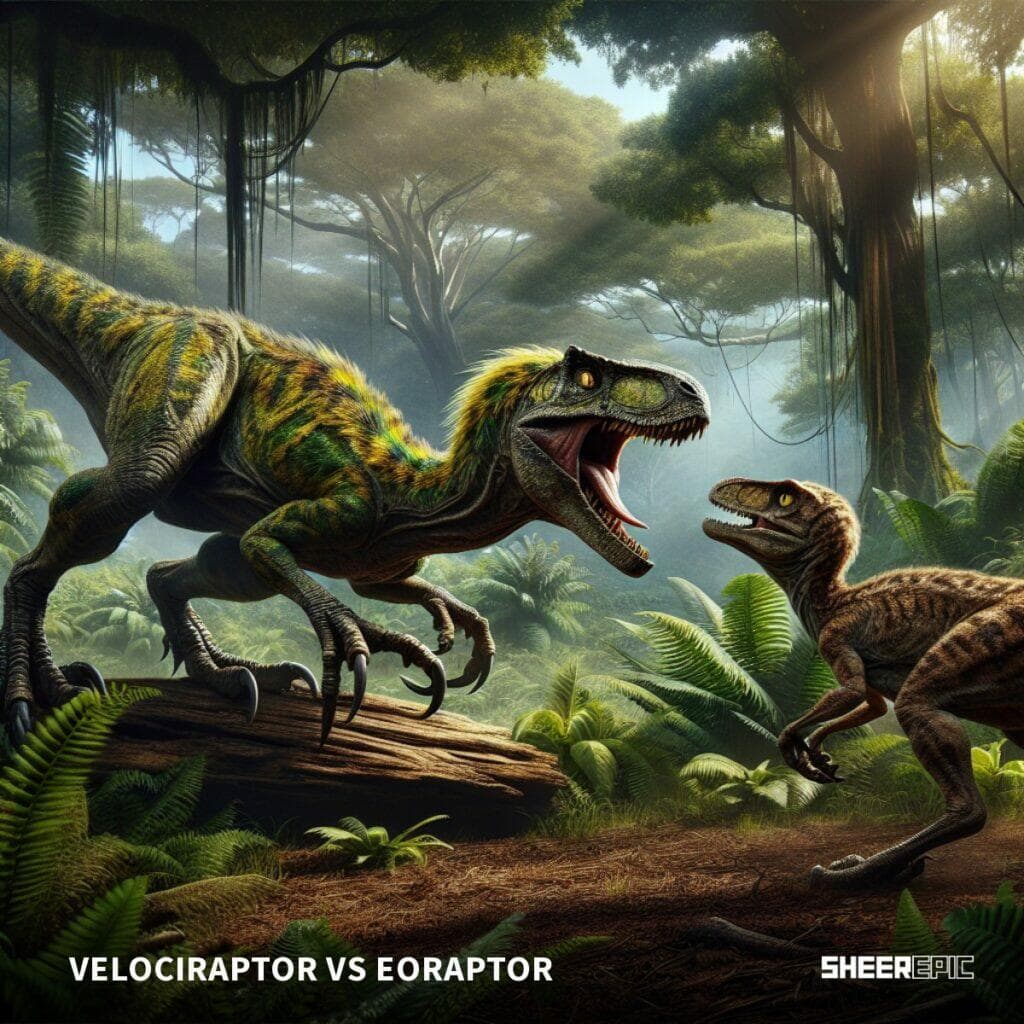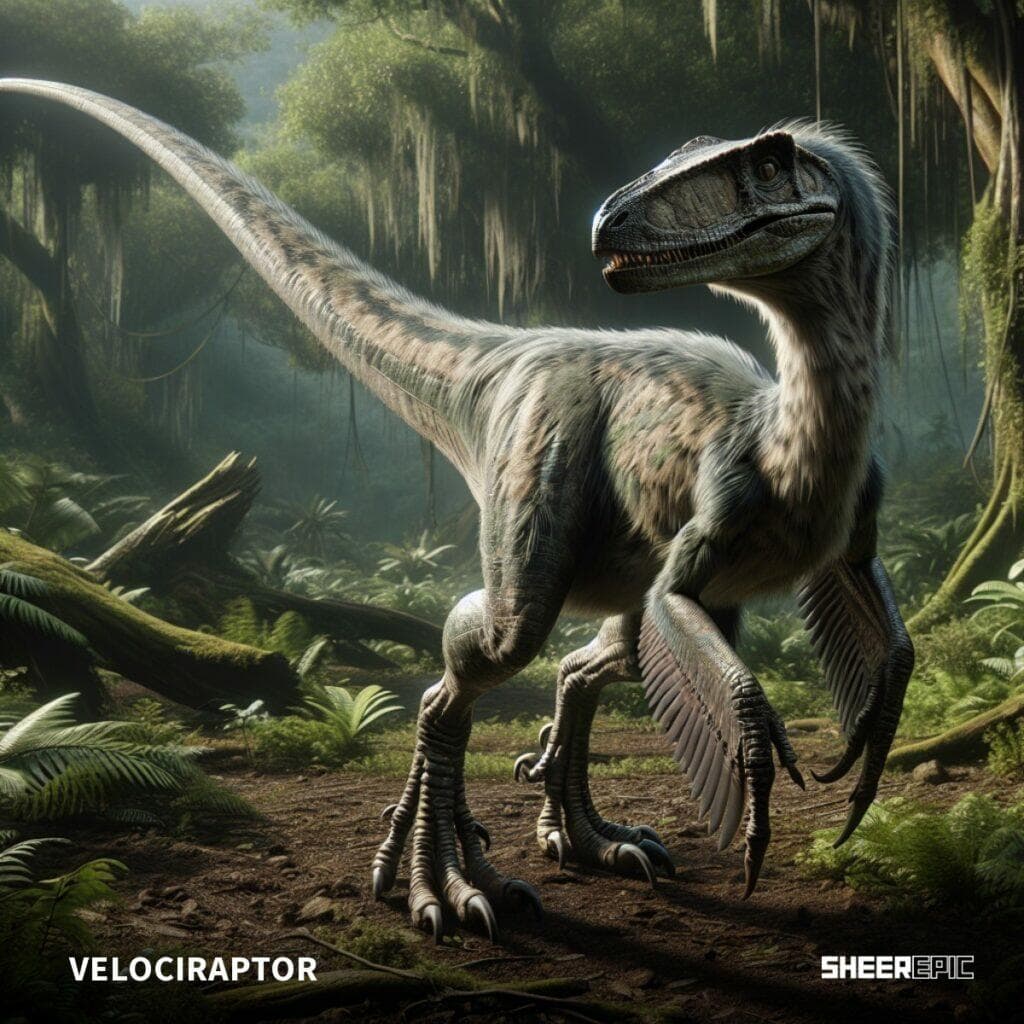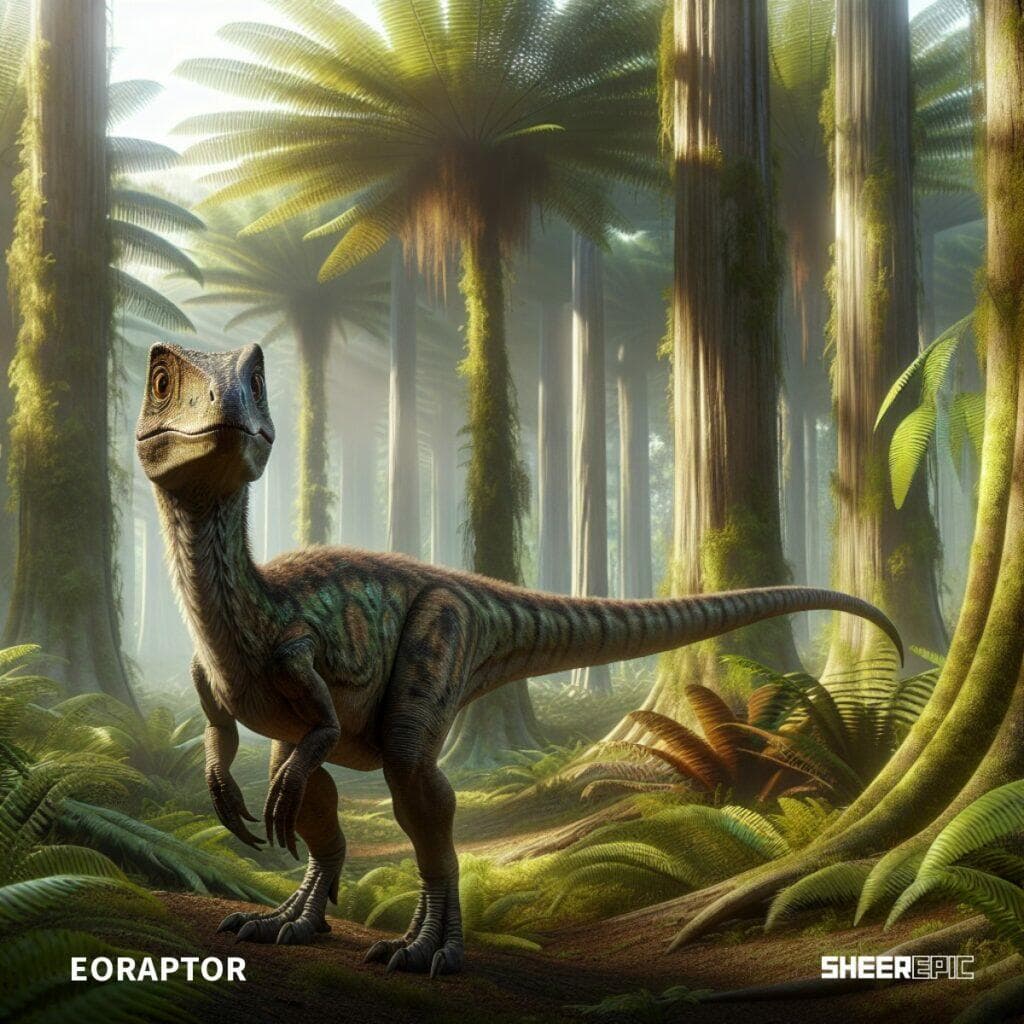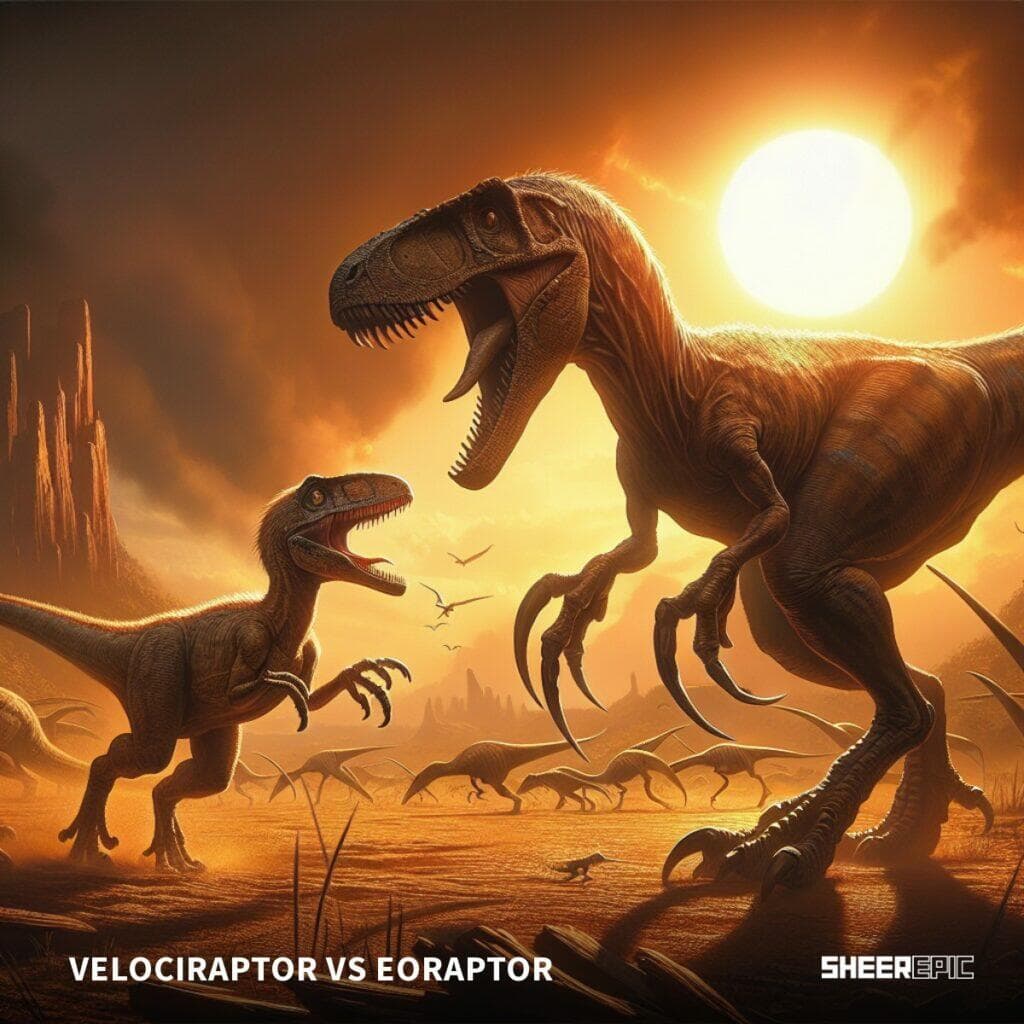In the world of prehistoric creatures, the Velociraptor and Eoraptor were two fascinating dinosaurs that roamed the Earth millions of years ago.
The Velociraptor, a small dromaeosaurid dinosaur from the Late Cretaceous epoch, was known for its agility and speed, while the Eoraptor, a small basal sauropodomorph, was one of the earliest-known dinosaurs from the Late Triassic period.
Their vastly different time periods and physical characteristics often spark curiosity and debate among dinosaur enthusiasts about what would happen if these two dinosaurs were to face off in a hypothetical battle.

A comparison between the Velociraptor and Eoraptor can reveal fascinating insights into their physical characteristics, diet, hunting patterns, and more. As we delve into the factors that may contribute to determining who would win in this prehistoric clash, we consider each dinosaur’s unique traits and features, such as their size, strength, and intelligence, as well as their social behaviors and defense mechanisms.
Key Takeaways
- Velociraptor and Eoraptor lived in different time periods and had distinct physical characteristics.
- Both dinosaurs had unique hunting strategies and diets, affecting their potential matchups.
- Intelligence, social behavior, and defense mechanisms would play crucial roles in determining the winner of a hypothetical battle.
Table of Contents
Comparison
Comparison Table
| Feature | Velociraptor | Eoraptor |
|---|---|---|
| Size | Velociraptors were relatively small dinosaurs, measuring up to 2 meters (6.8 feet) in length, and weighing around 15 kilograms (33 pounds). source | Eoraptor was also small in size, growing to about 1 meter (3.3 feet) in length, and weighing approximately 10 kilograms (22 pounds). source |
| Time Period | Velociraptors lived during the Late Cretaceous epoch, about 75 million to 71 million years ago. source | Eoraptor lived much earlier, during the Late Triassic period, approximately 231 to 228 million years ago. source |
| Habitat | Velociraptors were native to Asia, specifically in what is now modern-day Mongolia. source | Eoraptor lived in what is now Northwestern Argentina, part of Western Gondwana at the time. source |
| Diet | Velociraptors were carnivorous, primarily consuming small animals and possibly scavenging larger prey. source | Eoraptor was likely an omnivore, feeding on both small animals and plant material. source |
| Anatomy | Characterized by their long tails, dromaeosaurid lineage, and well-known sickle-shaped claws on their second toes. source | Eoraptor exhibits the basal sauropodomorph anatomy, with a light build, thin long head, and small serrated teeth. source |
Despite their size and time period differences, Velociraptor and Eoraptor share some similarities. Both dinosaurs were relatively small and agile, which may have helped them evade larger predators. However, the Velociraptor’s distinct sickle-shaped claw and its carnivorous diet likely made it a more efficient predator compared to the omnivorous Eoraptor.
In terms of physical prowess, the Velociraptor could potentially have an advantage due to its sickle-shaped claw and specialized hunting adaptations. However, it’s important to note that these two dinosaurs lived in vastly different ecosystems and time periods, which would have affected their overall abilities to survive and thrive in their respective environments.
Additionally, it’s worth noting that modern-day depictions of Velociraptors in popular culture often showcase them as highly intelligent pack hunters. While this portrayal adds an interesting dynamic to their potential combat abilities, it is based more on speculation than concrete evidence from the fossil record.
Physical Characteristics
Velociraptor and Eoraptor were both theropod dinosaurs, but they had several differences in their physical characteristics. Velociraptor, a small dromaeosaurid dinosaur, lived in Asia during the Late Cretaceous epoch, approximately 75 to 71 million years ago. On the other hand, Eoraptor, a small, lightly built basal sauropodomorph, resided in the region that is now northwestern Argentina during the Late Triassic, about 231 to 228 million years ago.

In terms of size, Velociraptor measured up to 6.8 feet (2.07 meters) in length and stood roughly 1.6 feet (0.5 meters) tall at the hip. Its estimated weight was around 33 pounds (15 kg).

Eoraptor, in contrast, was smaller, with an approximate length of 3.3 feet (1 meter) and an estimated weight of 22 pounds (10 kg).
The body morphology of Velociraptor and Eoraptor also differed. Velociraptor had a more streamlined body, which allowed it to move swiftly, earning it the name “swift thief.” Its body was well-adapted for hunting, as it possessed strong hind limbs for running and grasping forelimbs. In addition, the Velociraptor had a sharp, retractable sickle-shaped claw on each foot, a key feature for capturing and subduing its prey.
Eoraptor, on the other hand, had a slimmer body compared to Velociraptor and was lightly built. This basal sauropodomorph is considered one of the earliest-known dinosaurs, and its body morphology resembles a mix of primitive traits and anatomical features that evolved later in more advanced dinosaurs. It is believed that Eoraptor was agile, as a result of its slender build and long limbs.
Focusing on their bones, Velociraptor, like other theropods, had hollow bones, making them lighter and more agile. Its skull, notched with numerous sharp teeth, was relatively large compared to its body size. Eoraptor’s bones, on the other hand, were more primitive in structure, which is expected for a dinosaur from the early Triassic period.
Diet and Hunting
The Velociraptor and Eoraptor had distinct dietary habits and hunting strategies, given their significant differences in size and evolutionary timeline. The Velociraptor, a small dromaeosaurid dinosaur, lived around 75 to 71 million years ago in Asia during the Late Cretaceous epoch, while the Eoraptor, a small, lightly built, basal sauropodomorph dinosaur, inhabited Western Gondwana (now northwestern Argentina) approximately 231 to 228 million years ago during the Late Triassic period.
As a predatory dinosaur, the Velociraptor mainly fed on small animals like reptiles, amphibians, and smaller mammals. With its sharp teeth and curved claws, it had all the necessary tools for an effective hunt. Its predatory behavior often involved hunting in packs, making it a highly successful and coordinated hunter. Velociraptor exhibited opportunistic predator tendencies, meaning they adapted to various circumstances to exploit available food sources. Furthermore, it was considered one of the apex predators of its environment due to its intelligence and adaptability.
In contrast, the Eoraptor’s diet was more mixed, with evidence suggesting omnivorous tendencies. This dinosaur likely consumed both plant material and small prey, such as insects and small vertebrates. Its teeth and jaw structures were well-suited for gripping and grinding different types of food. Given the Eoraptor’s basal position in sauropod evolution, it could be inferred that its hunting strategies were more primitive than those of the Velociraptor.
Defense Mechanisms
When comparing the defense mechanisms of the two dinosaurs, Velociraptor and Eoraptor, it is important to consider their individual advantages and limitations. Both species have unique traits that would affect their ability to defend themselves or attack their opponents.
Velociraptor, known to be a small dromaeosaurid dinosaur, possessed several characteristics that could provide significant advantages in a confrontation. One of the key features is its claws. These highly adapted claws, particularly the large sickle-shaped claw on the second toe, were likely used as effective weapons against its prey. Moreover, their lighter, agile body allowed them to have impressive speed and agility. These attributes would contribute to their offensive capabilities and evasion techniques.

On the other hand, Eoraptor was a small basal sauropodomorph dinosaur and one of the earliest known dinosaurs. Compared to the Velociraptor, it had a lightly built body, which likely made it a relatively speedy and agile dinosaur as well. While there is less information available about the defense mechanisms of Eoraptor, it is reasonable to assume that it had some degree of offensive and defensive capabilities. However, there is no indication that it possessed the highly specialized claws found in the Velociraptor.
Comparable in size and agility, Velociraptors and Eoraptors may have had different approaches to their defense or attack strategies. Given the significant difference in specialized weaponry, such as Velociraptors’ prominent claws, and their potential for offensive capabilities, it would be reasonable to assume that a confrontation between these two species would be heavily influenced by these factors.
In conclusion, both dinosaurs had unique features, with the Velociraptor possessing notable claws and agility, and Eoraptor having a lightly built body, indicating potential for speed. While it is difficult to predict an exact outcome from such a confrontation, these attributes provide insight into their respective defense mechanisms and capabilities in the prehistoric world.
Intelligence and Social Behavior
Velociraptors were intelligent predators with keen instincts. They were agile and had a heightened sense of smell and hearing, which allowed them to hunt effectively and adapt to their environment. Moreover, their large brain relative to their body size suggests that they were highly intelligent.
It has been hypothesized that Velociraptors lived and hunted in packs, implying a certain degree of social behavior. This coordination in hunting strategies and prey capture would likely have allowed them to take down larger prey with greater success. Studies on fossils indicate that they may have had a complex vocal communication system.
In contrast, Eoraptor was a small, basal sauropodomorph dinosaur. It was one of the earliest-known dinosaurs and lived approximately 231 to 228 million years ago during the Late Triassic period. Although not much information is available about their intelligence or social behavior, their small size and primitive features suggest that they were not as advanced as Velociraptors.
Eoraptor’s intelligence is a subject of speculation due to the limited information available about their brain structure. However, it is unlikely that they exhibited social behaviors or lived in packs similar to Velociraptors. Their relatively simple anatomy, compared to the advanced and sophisticated Velociraptor, suggests that Eoraptor may not have been as skilled a hunter or had the keen instincts exhibited by Velociraptors.
In conclusion, based on the information available, it seems that Velociraptors were more intelligent and socially capable than Eoraptors. This advanced intellect and cooperative behavior would have given them a significant advantage in a confrontation. However, it is important to remember that these findings are based on existing studies and paleontological data, and new discoveries may lead to further insights into the behaviors and characteristics of these fascinating creatures.
Key Factors
In determining the possible outcome of a battle between a Velociraptor and an Eoraptor, several key factors should be taken into consideration. Both of these prehistoric dinosaurs were bipedal, meaning they walked on two legs, which facilitated swift and agile movement.
The Velociraptor was a small carnivorous dinosaur that lived in Asia during the Late Cretaceous epoch around 75 to 71 million years ago. Known for their speed and agility, Velociraptors were efficient predators, capable of reaching speeds up to 40 miles per hour. Additionally, they possessed a relatively large, sickle-shaped claw on each foot, which was used effectively in hunting and combat. Their strength and body structure allowed them to strike their prey quickly and efficiently.
On the other hand, the Eoraptor was a small, lightly built basal sauropodomorph dinosaur that lived approximately 231 to 228 million years ago, during the Late Triassic. Although it was one of the earliest known dinosaurs and an early member of the sauropod family, it exhibited traits that helped it adapt to its environment. Similar to the Velociraptor in size, it was also an agile and fast-moving creature. However, the Eoraptor was believed to be an omnivore, indicating that it may not have had the same level of predatory instinct or capabilities.
Regarding their bipedal movement, both the Velociraptor and the Eoraptor possessed a striding gait that contributed to their agility and speed. While the Velociraptor relied more on its fearsome claws and predatory instincts for strength and hunting prowess, the Eoraptor’s strength may have come more from its adaptability and varied diet.
In summary, the key factors to consider in a matchup between a Velociraptor and an Eoraptor include their bipedal movement, striding gait, type of movement, and individual strengths. Although the Velociraptor may have had an edge in predatory capabilities, both creatures were remarkably agile, giving either contender a fighting chance in such a confrontation.
Who Would Win?
In a hypothetical battle between a Velociraptor and an Eoraptor, several factors would come into play to determine the winner.
Firstly, we must consider the size difference between the two dinosaurs. Velociraptors, living approximately 75 to 71 million years ago, measured around 2 meters long and weighed about 15 kilograms. On the other hand, Eoraptors, an earlier dinosaur species living around 231 to 228 million years ago, had a similar body length, but were lighter, weighing only about 10 kilograms. This might give Velociraptors an edge in terms of physical strength.
Another crucial aspect is their respective weaponry. Velociraptors are known for their sharp, curved claws, particularly on their second toe, which could measure up to 6.5 centimeters in length. They likely used these claws to slash at the throats and bellies of their prey. Although Eoraptors also had sharp teeth and claws, their relatively primitive anatomy may not have granted them the same level of effectiveness in combat.

Comparing the agility and speed of these two dinosaurs, we can infer that Velociraptors were most likely faster and more agile. As a member of the dromaeosaurid family, they were built for speed and had long, slender legs, which would have allowed them to cover large distances quickly. In contrast, the Eoraptor’s more basal sauropodomorph anatomy might have made it somewhat less suited for rapid movement.
Lastly, the intelligence of these prehistoric creatures could play a part in the outcome of the battle. Although it is difficult to precisely measure the intelligence of extinct animals, Velociraptors are generally considered to be one of the smarter dinosaur species due to their relatively large brain size compared to their body weight. This cognitive edge may have allowed them to outthink and outmaneuver their opponents.
Taking into account the differences in size, weaponry, agility, and intelligence, it seems that in a head-to-head fight, the Velociraptor would have a significant advantage over the Eoraptor.
Frequently Asked Questions
What physical attributes do Velociraptors and Eoraptors have?
Velociraptors were small dromaeosaurid dinosaurs that lived in Asia during the Late Cretaceous epoch, about 75 million to 71 million years ago. They had a lightweight body, slender limbs, and were roughly the size of a turkey, reaching up to 6.8 feet in length and weighing around 33 pounds. They had sharp, curved claws on their feet, along with a stiffened tail that allowed them to balance and maneuver while hunting.
Eoraptors, on the other hand, were small, basal sauropodomorph dinosaurs that lived approximately 231 to 228 million years ago during the Late Triassic in Western Gondwana. They were lightly built, with a similar body size to Velociraptors, but were less specialized in their physical adaptations.
How does the speed and agility of a Velociraptor compare to that of an Eoraptor?
Though there is no direct evidence of their exact speeds, it is believed that Velociraptors were likely faster and more agile than Eoraptors, due to their specialized adaptations such as a stiffened tail and lightweight body. Eoraptors, while bipedal and likely capable of running, would not have been as fast or agile as their later, more specialized relatives.
What were the hunting techniques used by Velociraptors and Eoraptors?
Velociraptors are often depicted as pack-hunting predators, using their speed, agility, and sharp claws to ambush and subdue prey. However, there is still debate among paleontologists about their actual hunting strategies.
Eoraptors, as basal sauropodomorphs, may have been omnivorous or carnivorous, but not much is known about their specific hunting techniques.
How does the intelligence of Velociraptors compare to Eoraptors?
Historically, theropod dinosaurs such as Velociraptors have been considered to possess relatively high levels of intelligence when compared to other dinosaur groups. In contrast, little is known about the intelligence of Eoraptors, as they are much older and less studied. It can only be inferred that their intelligence was likely lower than that of more advanced theropods like Velociraptor.
What was the primary prey of Velociraptors and Eoraptors?
Velociraptors likely preyed on small to medium-sized animals living in their habitats, such as Protoceratops and other small dinosaurs. Eoraptors, being less specialized, may have had a more varied diet, potentially including small animals, insects, and even plant material.
How do the environments of Velociraptors and Eoraptors compare?
Velociraptors lived in Asia during the Late Cretaceous epoch, with evidence suggesting that their habitats were likely semi-arid environments, such as sand dunes and open plains.
Eoraptors lived during the Late Triassic in Western Gondwana, in what is now northwest Argentina. Their environment is believed to have been more diverse, including floodplains, river basins, and arid deserts.


